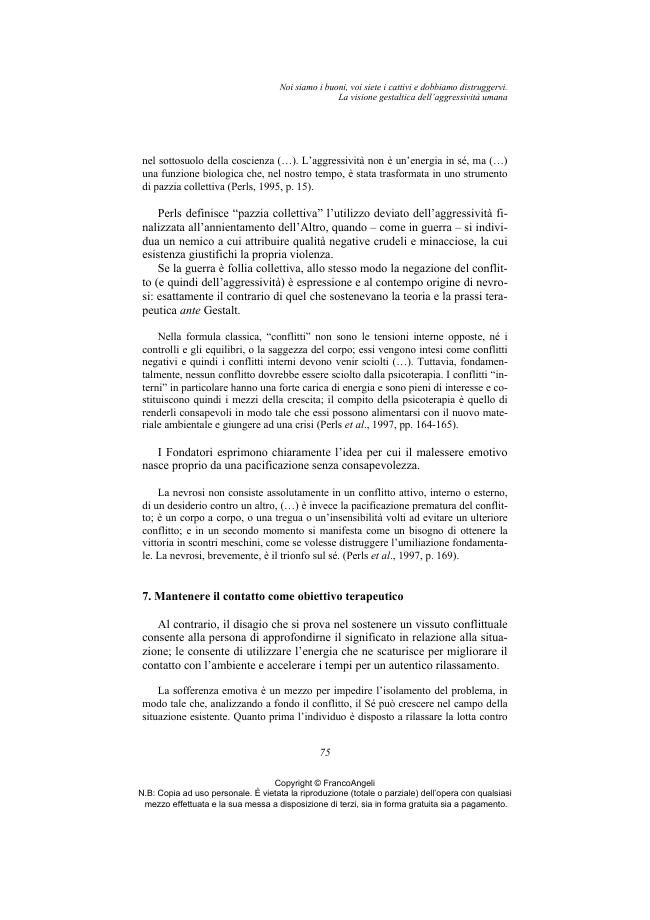Noi siamo i buoni, voi siete i cattivi e dobbiamo distruggervi : la visione gestaltica dell'aggressività umana
P. 65-84
Il terapeuta della Gestalt tende a leggere - in un'ottica olistica e contestuale - i movimenti che caratterizzano la società odierna, intrisa di rabbia e di violenza (la guerra in Ucraina ne è un esempio). L'aggressività è, da sempre considerata, dalla teoria gestaltica, come la naturale spinta alla crescita e al cambiamento. Il terapeuta ha la missione di favorire il sano adgredere co-me intenzionalità di contatto, e di prevenire la violenza - che è la degenerazione dell'aggressività del sé desensibilizzato. Un esempio clinico illustra il modo in cui è possibile centrare questo obiettivo. [Testo dell'editore]
The Gestalt therapist tends to read - from a holistic and contextual perspective - the movements that characterise today's society, steeped in anger and violence (the war in Ukraine is an example). Aggression has long been considered, by mainstream psychological models, as a biologically determined instinct with an adaptive purpose. Gestalt theory frames the con-cept of aggression as the natural drive for growth and change and distinguishes it from that of violence. Perls speaks of it in Ego Hunger and Aggression - the text that already contains in embryo some of the central ideas of Gestalt psychotherapy - as a propulsive force that allows the human organism to move in the world to satisfy its vital needs. In Gestalt Therapy, Perls and Goodman specifically focus the distinction between aggression and annihilation in light of the concept of contact between organism and environment.
According to this new perspective, the therapist's mission is to foster the healthy ad-gress of his patients as contact intentionality, and to prevent violence - which is the degeneration of aggression of the desensitised self - as a desire to annihilate one's opponent. Looking the enemy in the eye" means maintaining con-tact with the Other even when experiencing feelings of animosity, anger and resentment: this is how to turn conflict into an opportunity for growth and awareness. In this article, a clinical example illustrates how this can be achieved. Drawing a parallel between the therapeutic set-ting and the broader relational context, even at the social level, the therapist can embody the role of facilitator of relations between opposing groups and sides, between communities and even between nations in conflict. Here again, the intention is to shift the focus of interest to the situation that the disputants are experiencing, to what unites them and their relationship.
If the basic principle becomes the mutual recognition of all those experiencing the conflict in the giv-en context, it is impossible to desire the destruction of the Other and to take pleasure in it. [Publisher's text]
-
Articoli dello stesso fascicolo (disponibili singolarmente)
-
Informazioni
Codice DOI: 10.3280/GEST2022-002005
ISSN: 2035-6994
MATERIE
PAROLE CHIAVE
- Aggressività, violenza, conflitto, situazione, contatto
- Aggression, violence, conflict, situation, contact



